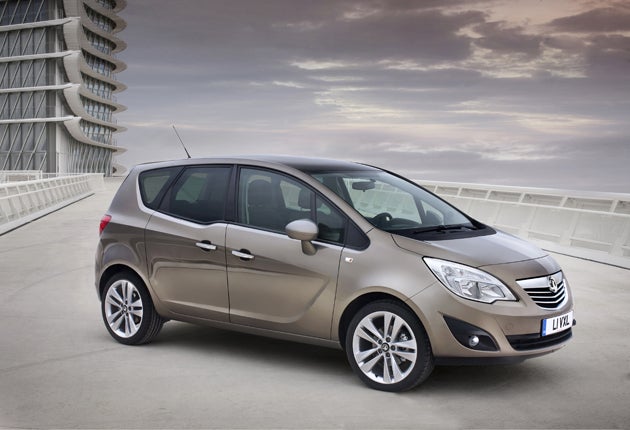Vauxhall Meriva MPV
Vauxhall has put a lot of thought into its new Meriva – and the result is a useful, good-looking and likeable multi-purpose vehicle

Your support helps us to tell the story
From reproductive rights to climate change to Big Tech, The Independent is on the ground when the story is developing. Whether it's investigating the financials of Elon Musk's pro-Trump PAC or producing our latest documentary, 'The A Word', which shines a light on the American women fighting for reproductive rights, we know how important it is to parse out the facts from the messaging.
At such a critical moment in US history, we need reporters on the ground. Your donation allows us to keep sending journalists to speak to both sides of the story.
The Independent is trusted by Americans across the entire political spectrum. And unlike many other quality news outlets, we choose not to lock Americans out of our reporting and analysis with paywalls. We believe quality journalism should be available to everyone, paid for by those who can afford it.
Your support makes all the difference.This is Vauxhall's new Meriva MPV. It looks a cleverly-conceived car, with its wavy waistline and rear-hinged rear doors, and it is. What it is not, though, is a direct replacement for the old one. Because, as with so many new cars, it has grown. The Meriva used to be a mini-MPV. Not any more.
You can see the logic. Vauxhall's other MPV is the Zafira, a full seven-seater. So it's quite big; bigger, for example, than the Renault Scenic and Ford C-Max. So Vauxhall needed a clearer rival for these cars, more than it needed a direct replacement for the old Meriva which was never a huge seller. The new Meriva, on sale from June and from £15,495, is it.
It's roomier than the old one. But that fact is a mere sideshow compared with its other niceties, beginning with "FlexDoors". An MPV is very likely to be used by families – that's the point, after all – so it makes sense to let young and old occupy a communal space during the boarding process, instead of having a back door in the way.
The doors open out a long way, too, so passengers don't feel hemmed in. And, unlike smaller rear-hinged doors found in, say, a Mini Clubman or a Mazda RX-8, the rear doors can be opened without the front ones being opened first. A self-locking device activates over 2mph to overcome the safety objection, that if a door were to be opened accidentally while the car was moving, the wind would fling it back. And then there's the cabin.
As before, the rear seats slide back and forth as needed. And when they are in their rearmost position you can fold down the narrower centre seat and slide the outer ones nearer to each other, creating a four-seater car with lots of shoulder room for the rear passengers. It's a neat trick, but wherever the rear seats are set, you can still see into the boot space past the luggage blind. The rear seats also fold fully flat to create a large load space.
Then there's the "FlexRail". This actually consists of two rails set between the front seats, each with two tracks. The upper one carries an armrest and big storage box, the lower one a storage tray with a cupholder. Both can be slid into different positions or removed entirely, and there's another tray under the whole ensemble with more cupholders, a power socket and USB/jack-plug sockets for MP3 players. The lack of a conventional handbrake (it's electric instead) makes all this possible.
Now it's time for a drive. The previous Meriva was nothing special here, except that there was a racy VXR version which was massively entertaining to drive and which no one bought. Its turbocharged liveliness proved prescient, because now two of the three available petrol engines are again turbocharged to give them the energy of engines rather larger than their 1.4 litres. With 120bhp or 140bhp, these engines fit today's downsizing mantra perfectly. I tried both; a 100bhp non-turbo and two diesels are also offered.
The 120bhp version feels less powerful than it is, but at least its CO2 output is fractionally lower than the non-turbo car's. So the 140bhp Meriva is the one to have, if you can justify the extra £775, because it has enough spark to make it properly fun to drive even if it's no VXR. It gets a six-speed gearbox, too.
Both cars cope well with bumps, and our Vauxhall Merivas (as opposed to mainland Europe's Opels) have UK-specific settings for their electric power steering. These reduce the glutinous resistance too often found in such systems, so the steering self-centres more easily and feels more natural around the straight-ahead. Quite why other countries should want it any other way is hard to fathom.
One curious aspect of the Meriva's marketing is that the version called Exclusiv is not the top model. That role belongs to the presumably more-Exclusiv SE. Never mind; it doesn't stop the new Meriva from being a useful, likeable, good-looking and well-thought-out MPV.
The Rivals
Citroen C4 Picasso 1.6 THP 150: from £19,405.
Spacious, more wieldy than seven-seat Grand. Airily futuristic outside and in. Turbo petrol engine is high spot in otherwise dull drive.
Ford Focus C-Max 1.8: from £17,665.
Typically excellent Focus driving feel, but 125bhp engine is dated. Rear seats slide and converge like Meriva's. New model arrives soon.
Mercedes-Benz A180: from £16,780.
Keenly-priced. A-class looks neat, has "premium" feel, and is fun to drive. Not quick (116bhp), but it deserves to be more popular.
Join our commenting forum
Join thought-provoking conversations, follow other Independent readers and see their replies
Comments